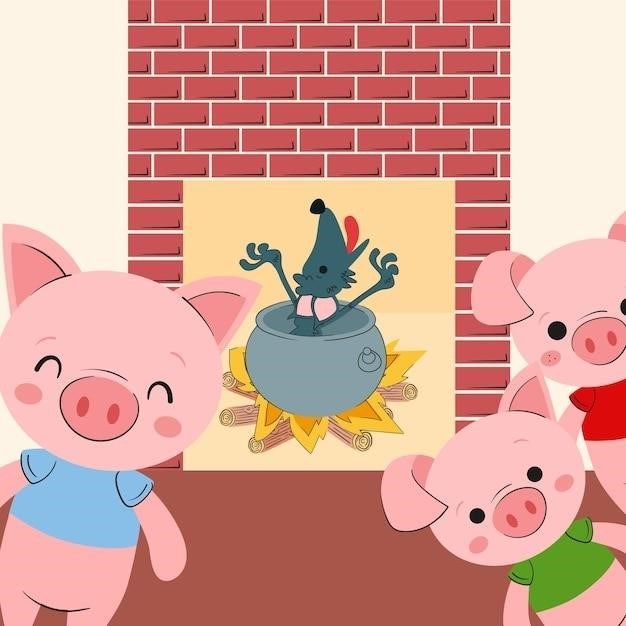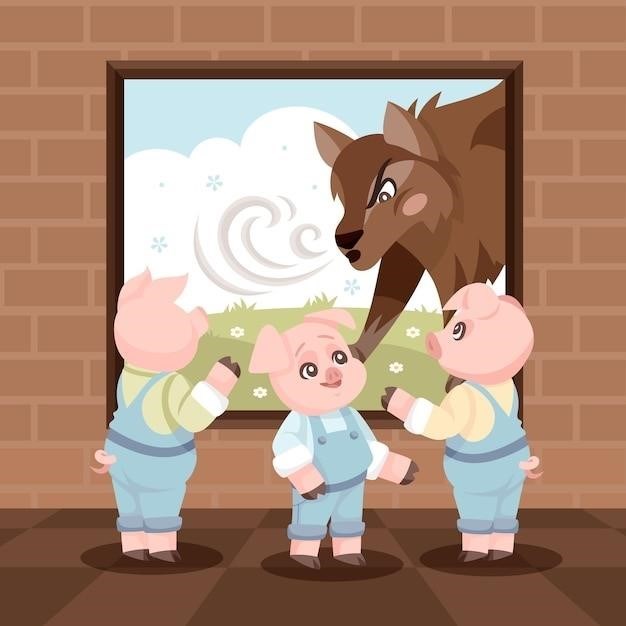The Three Little Pigs PDF⁚ A Comprehensive Overview
Explore numerous online resources offering “The Three Little Pigs” in PDF format. These versions vary in illustrations, text length, and accompanying educational materials, catering to diverse age groups and reading levels. Discover classic tales and modern adaptations alike.
Available Versions and Formats
The classic fairy tale, “The Three Little Pigs,” enjoys widespread availability in diverse PDF formats online. You’ll find versions tailored for early childhood education, featuring simplified language and colorful illustrations ideal for young readers. Other PDFs cater to older children and adults, offering the complete story with richer vocabulary and potentially including comprehension questions for educational purposes. Some versions even integrate interactive elements or audio components, enhancing engagement and learning. The availability of these different formats reflects the enduring popularity of the story and its adaptability to various learning styles and age groups. Furthermore, you may encounter PDFs with different artistic styles, ranging from simple line drawings to more complex and detailed illustrations, catering to diverse aesthetic preferences. The accessibility of these varied resources ensures that everyone can access and enjoy this timeless tale in a format suitable to their needs.
Story Variations and Adaptations
While the core narrative of “The Three Little Pigs” remains consistent—three pigs building houses of varying sturdiness, facing a cunning wolf— numerous adaptations exist. Some versions emphasize the pigs’ personalities more distinctly, giving each a unique character trait beyond their building choices. Others modify the wolf’s character, portraying him as more cunning or less menacing. The ending also sees variations; some versions feature a more decisive victory for the pigs, while others might add additional challenges or plot twists. Modern adaptations often incorporate elements of humor or suspense, appealing to a contemporary audience. These variations reflect the story’s adaptability and its enduring appeal across generations. The inclusion of diverse illustrations and accompanying activities further contributes to the multifaceted nature of these adaptations found in available PDF versions.
Moral Lessons and Themes
The enduring popularity of “The Three Little Pigs” stems from its clear and impactful moral lessons. The story powerfully illustrates the importance of hard work and diligent preparation. The pig who builds his house of bricks demonstrates foresight and perseverance, ultimately ensuring his safety. This contrasts sharply with the laziness of the other pigs, highlighting the consequences of shortcuts and insufficient effort. Furthermore, the tale explores themes of resourcefulness and ingenuity. The pigs’ ability to construct homes from readily available materials showcases their problem-solving skills. The story also subtly touches upon themes of resilience and facing adversity. The pigs’ determination to protect themselves from the wolf’s threats emphasizes the importance of courage and self-reliance. These interwoven messages make “The Three Little Pigs” a timeless and valuable teaching tool.

Analyzing the Narrative
This section delves into the story structure, character development (pigs and wolf), setting, and the overall atmosphere of the classic fairy tale.
Character Development⁚ Pigs and Wolf
The Three Little Pigs showcases distinct character development, highlighting contrasting personalities and choices among the three siblings. The first two pigs are portrayed as impulsive and prioritizing leisure over diligent work, leading to the construction of flimsy homes. Their actions emphasize the importance of preparedness and foresight. In contrast, the third pig demonstrates prudence and diligence, meticulously building a durable brick house. This careful planning ultimately saves his life. The Big Bad Wolf, a classic villain, represents deceit and aggression, relentlessly pursuing the pigs for his meal. His failure to penetrate the brick house underscores the importance of resilience and resourcefulness. The contrasting characters create a compelling narrative that explores themes of hard work, responsibility, and the consequences of poor choices. The wolf’s persistent attempts highlight the ever-present dangers and the need for preparedness.
Plot Structure and Key Events
The narrative of “The Three Little Pigs” follows a clear and simple plot structure. It begins with the three pigs leaving their mother’s home to build independent houses. This establishes the central conflict⁚ the pigs’ vulnerability to the Big Bad Wolf. The rising action involves the wolf’s attempts to enter each pig’s house, starting with the straw and stick houses, easily destroyed due to the pigs’ poor choices in construction materials. This creates suspense and builds towards the climax. The climax occurs when the wolf encounters the brick house, his efforts to enter proving futile. This highlights the consequence of the third pig’s responsible actions. The falling action is brief, showing the wolf’s defeat and the pigs’ safety. The resolution is the pigs’ triumphant survival, emphasizing the importance of hard work and planning. This straightforward plot structure makes the story accessible and engaging for young readers.
Setting and Atmosphere
While not explicitly detailed, the setting of “The Three Little Pigs” is generally understood to be a rural, perhaps wooded area, conducive to the pigs’ independent house-building. The atmosphere is one of initial lightheartedness and naiveté, as the pigs playfully build their homes. This contrasts sharply with the mounting tension as the Big Bad Wolf appears, creating a sense of impending danger and suspense. The wolf’s arrival shifts the atmosphere from carefree to apprehensive. The repeated attempts to blow down the houses increase the feeling of threat. Finally, the safe, sturdy brick house provides a sense of security and relief. The overall atmosphere thus oscillates between lightheartedness, suspense, and ultimate triumph, mirroring the story’s simple yet engaging plot. The setting’s simplicity allows the focus to remain firmly on the characters and the unfolding events.

Educational Applications
PDF versions of “The Three Little Pigs” serve as valuable early literacy tools, fostering reading comprehension and vocabulary development. They also offer opportunities for moral discussions about hard work and preparedness.
Use in Early Childhood Education
The readily available PDF versions of “The Three Little Pigs” are incredibly versatile tools for early childhood educators. The simple narrative and repetitive phrases make it ideal for emergent readers, building confidence and fluency. Teachers can utilize the story to introduce key vocabulary, focusing on words like “straw,” “sticks,” and “bricks,” enriching language acquisition. The vibrant illustrations often found in these PDFs enhance comprehension and engagement, particularly for visual learners. Interactive activities can be designed around the story, such as building houses from different materials or role-playing the characters. Furthermore, the tale’s clear moral message – the importance of hard work and planning – provides opportunities for discussions about choices and consequences, fostering crucial social-emotional development in young children. The PDF format offers flexibility; teachers can easily print copies for individual use or project the story onto a screen for group storytelling. Its accessibility makes it a valuable resource for classroom instruction and home learning alike, making it a pivotal tool in shaping early literacy skills and moral understanding.
Language Learning Resources
PDF versions of “The Three Little Pigs” serve as excellent language learning resources, particularly for English as a Second Language (ESL) or English as a Foreign Language (EFL) instruction. The straightforward language and repetitive structures make the story easily accessible to learners of varying proficiency levels; Teachers can use the text to introduce new vocabulary, focusing on descriptive words related to the houses, characters, and actions. The story provides ample opportunities for practicing sentence construction and simple grammar rules. Furthermore, the narrative’s clear plot and engaging characters enhance comprehension and retention. The PDF format allows for easy adaptation; teachers can highlight key words, create fill-in-the-blank exercises, or design interactive activities based on the story. Audio versions paired with the PDF can further improve pronunciation and listening skills. The accessibility and adaptability of these PDFs make them invaluable tools for language acquisition, fostering both reading and speaking skills within a familiar and engaging context.
Moral Development and Life Lessons
The enduring popularity of “The Three Little Pigs” stems from its clear moral message⁚ hard work and diligence lead to success, while shortcuts result in negative consequences. The story implicitly teaches the importance of planning and preparation. The third pig’s wise decision to build a sturdy brick house, despite the extra effort required, contrasts sharply with his brothers’ hasty construction of houses made of straw and sticks. This highlights the value of perseverance and the long-term benefits of careful planning. Children readily grasp this lesson, learning that investing time and effort in a task ultimately pays off. The story also subtly introduces the concept of consequences – the lazy pigs face danger due to their lack of foresight. By illustrating the contrast between the pigs’ choices and their outcomes, the tale encourages responsible decision-making and emphasizes the importance of hard work and foresight in achieving goals. It serves as a valuable tool for discussions about planning, effort, and the rewards of perseverance.
Leave a Reply
You must be logged in to post a comment.